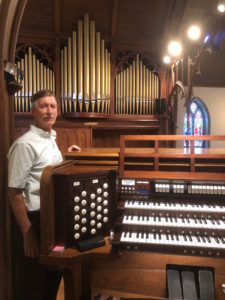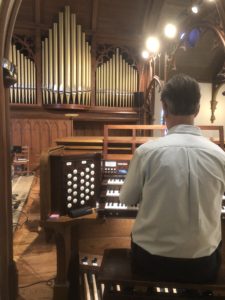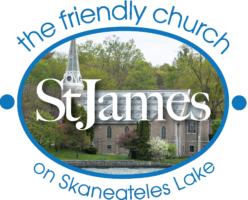A History of the Organs at St. James’

The current Skinner organ is the fourth organ to “raise a joyful noise to the Lord” from St. James’ Episcopal. The first was bought for $200 in 1828, built by Ellsworth Phelps, with a mahogany case and “gilt front show pipes.” A writer in 1831 noted that the organ had a “small but sweet tone.” Others recalled the first organ’s most
memorable feature, an angel in a blue gown, floating amongst rose colored clouds and holding a trumpet, painted on the case by one Parley Cleaveland, perhaps a painter at one of the local carriage works.
All we know of the second organ is that it arrived in 1854, when the first organ was donated to a church in Owasco, and that it did not make the trip to our new and current church building. The present church was completed in 1874. The architect was Horatio Nelson White who also designed the Gridley Building (1867) in downtown Syracuse, and the Hall of Languages (1873) at Syracuse University. The first instrument in this sanctuary was an organ built by Hilborne and Frank Roosevelt (first cousins of Theodore) and donated

by members of the Roosevelt family to honor the memory of Lydia Roosevelt and Henry Latrobe Roosevelt. Lydia had served as the church’s organist for 30 years. In 1927, the Roosevelt organ was sold to Emmanuel Church in East Syracuse where it is still is existence, and the present Ernest M. Skinner organ (Opus 644) was installed, with the console in the southwest corner of the sanctuary. In 1959, the organ console was moved to its present location
on the east side of the chancel. Restoration work and the addition of ten ranks of pipes was undertaken by Mann & Trupiano of New York City and Kerner & Merchant of Syracuse, New York. The new 8’ Octave pipes of the pedal serve as the major component of the new facade.
The facade work was given by the McMaster family as a memorial to Andrew McMaster, a longtime member and former warden of the parish.
Specifications for the St. James’ Organ Ernest M. Skinner Organ Opus 644, 1927 Restoration and additions Mann & Trupiano, 2004
Kerner & Merchant, 2006
Great (II) 16’ Pedal Bourdon 8’ Diapason 8’ Principal (Pedal) 8’ Claribel Flute 4’ Octave (new) 4’ Flute 2’ Fifteen (new) IV Mixture (new) 8’ Tromba Chimes
Choir (I)
8’ Diapason
8’ Concert Flute
8’ Gamba
8’ Dulciana
4’ Harmonic Flute
22/3’ Nazard (new)
2’ Piccolo (new)
13/5’ Tierce (new)
8’ Clarinet
8’ Tromba (Gt.)
Tremolo
8’ Diapason
8’ Concert Flute
8’ Gamba
8’ Dulciana
4’ Harmonic Flute
22/3’ Nazard (new)
2’ Piccolo (new)
13/5’ Tierce (new)
8’ Clarinet
8’ Tromba (Gt.)
Tremolo
Swell (III)
16’ Bourdon
8’ Diapason
8’ Salicional
8’ Vox Celeste
8’ Chimney Flute
8’ Flute Celeste (II rks)
4’ Principal (revoiced from original Great Octave)
4’ Flute
2’ Piccolo
III Mixture
8’ Cornopean
8’ Oboe d’Amour
8’ Vox Humana
Tremolo
16’ Bourdon
8’ Diapason
8’ Salicional
8’ Vox Celeste
8’ Chimney Flute
8’ Flute Celeste (II rks)
4’ Principal (revoiced from original Great Octave)
4’ Flute
2’ Piccolo
III Mixture
8’ Cornopean
8’ Oboe d’Amour
8’ Vox Humana
Tremolo
Pedal
16’ Diapason
16’ Bourdon
16’ Sw. Echo Bass
102/3’ Bass Quint
8’ Octave (new)
8’ Bourdon
8’ Sw. Still Gedeckt
4’ Octave (extension of 8’)
16’ Tromba (new extension from Gt)
16’ Diapason
16’ Bourdon
16’ Sw. Echo Bass
102/3’ Bass Quint
8’ Octave (new)
8’ Bourdon
8’ Sw. Still Gedeckt
4’ Octave (extension of 8’)
16’ Tromba (new extension from Gt)
